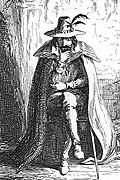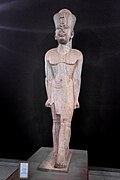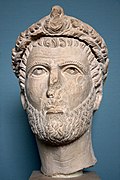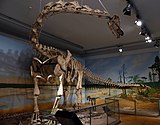Wikipedia:Today's featured article/November 2019
| << | Today's featured articles for November 2019 | >> | ||||
|---|---|---|---|---|---|---|
| Su | Mo | Tu | We | Th | Fr | Sa |
| 1 | 2 | |||||
| 3 | 4 | 5 | 6 | 7 | 8 | 9 |
| 10 | 11 | 12 | 13 | 14 | 15 | 16 |
| 17 | 18 | 19 | 20 | 21 | 22 | 23 |
| 24 | 25 | 26 | 27 | 28 | 29 | 30 |
November 1
"No Such Thing as Vampires" is the pilot episode of the American paranormal romance television drama Moonlight. Premiering on CBS on September 28, 2007, it was written by series creators and executive producers Trevor Munson and Ron Koslow and directed by executive producer Rod Holcomb. The pilot introduces Mick St. John (Alex O'Loughlin, pictured), a private investigator and a vampire, along with his love interest Beth Turner (Sophia Myles), his mentor Josef Kostan (Jason Dohring), and his ex-wife Coraline Duvall (Shannyn Sossamon). Originally titled Twilight, the project was renamed and recast when picked up by CBS for the 2007–2008 American television season. Although received poorly by critics, the pilot managed to finish first for its night among total viewers and adults 18–49. Many critics faulted the acting and writing, but some thought that the series showed promise, and Dohring's performance was praised. (Full article...)
November 2
November 3
November 4
November 5
Guy Fawkes (1570–1606) was one of a group of English Catholics who planned the Gunpowder Plot of 1605, the failure of which is commemorated in Britain every 5 November as Guy Fawkes Night. He converted to Catholicism and fought for Spain in the Eighty Years' War against Protestant Dutch reformers in the Low Countries. In Spain he sought support for a Catholic rebellion in England, but the court of Philip III was unwilling to help him. He later met Thomas Wintour, returned to England, and was introduced to Robert Catesby, who planned to assassinate King James I and restore a Catholic monarch to the throne. The plotters leased an undercroft beneath the House of Lords in Westminster Palace, and Fawkes was placed in charge of the gunpowder that they stockpiled there. The authorities found Fawkes guarding the explosives. He was arrested and died after falling from the scaffold where he was to be hanged. (This article is part of a featured topic: Gunpowder Plot.)
November 6
The relationships between
November 7
The
November 8
The letter-winged kite (Elanus scriptus) is a small, rare bird of prey that is found only in Australia. Measuring around 35 cm (14 in) in length with a wingspan of 84–100 cm (33–39 in), the adult has predominantly pale grey and white plumage and prominent black rings around its red eyes. It gains its name from a distinctive black "M" or "W" shape on the underwing, seen when in flight. This marking distinguishes it from the otherwise similar black-shouldered kite. The species begins breeding rapidly in response to rodent outbreaks, with pairs nesting in loose colonies of up to 50 birds each. Three to four eggs are laid and incubated for around 30 days, though the eggs may be abandoned if the food source disappears. Chicks are fledged within five weeks of hatching. Roosting in well-foliaged trees during the day, the letter-winged kite hunts for rodents mostly at night, hovering in midair above grasslands and fields. (Full article...)
November 9
The early history of the kingdoms of Gowa and Talloq can be traced back to 1300, when the Makassar kingdom of Gowa emerged as an agrarian chiefdom in the Indonesian peninsula of South Sulawesi. Talloq was founded two centuries later when a prince from Gowa fled to the coast after his defeat in a succession dispute. The coastal location of the new polity allowed it to exploit maritime trade to a greater degree than Gowa. The growth of early Gowa was supported by a rapid increase in wet rice cultivation. Verdant forests were cleared to make way for rice paddies. The population may have increased tenfold between the thirteenth and sixteenth centuries. Gowa and Talloq became close allies in the sixteenth century and dominated most of the peninsula, following wide-ranging administrative and military reforms. Around 1600 the twin kingdoms converted to Islam, defeated their rivals and became the most important powers in eastern Indonesia, with Fort Somba Opu (pictured) as one of their centers. (Full article...)
November 10
Mary Bell (3 December 1903 – 6 February 1979), nicknamed "Paddy", was an Australian aviator and founding leader of the Women's Air Training Corps, a volunteer organisation that provided support to the Royal Australian Air Force (RAAF) during World War II. She later helped establish the Women's Auxiliary Australian Air Force (WAAAF), the first and largest women's wartime service in the country, which grew to more than 18,000 members by 1944. Born Mary Fernandes in Launceston, Tasmania, she married John Bell, an RAAF officer, in 1923 and obtained a pilot's licence in 1927. Given temporary command of the WAAAF on its formation in 1941, she was passed over as its inaugural director in favour of corporate executive Clare Stevenson. Bell refused the post of deputy director and resigned, but later rejoined and served until the final months of the war. She and her husband became farmers after leaving the military. (Full article...)
November 11
Northampton War Memorial is a First World War memorial on Wood Hill in the centre of Northampton, the county town of Northamptonshire, in central England. Designed by architect Sir Edwin Lutyens and unveiled on 11 November 1926, it stands in a small garden in what was once part of the churchyard of All Saints' Church. It is one of the more elaborate town memorials in England, with a pair of obelisks, characteristic of the Lutyens war memorials, and a Stone of Remembrance, which he designed for the Imperial War Graves Commission. Stone flags appear as if draped on the obelisks; this feature is shared by several of his memorials, but was rejected for his Cenotaph in London. Today the Northampton War Memorial is a Grade I listed building; it was upgraded from Grade II in 2015 when the Lutyens war memorials were declared a "national collection" and all were granted listed building status or had their listing renewed. (Full article...)
November 12
Operation Catechism was a British air raid of World War II that resulted in the destruction of the German battleship Tirpitz (depiction shown). On 12 November 1944, 29 Royal Air Force heavy bombers targeted the battleship at an anchorage near the Norwegian city of Tromsø. The ship capsized after being struck by at least two bombs and damaged by the explosions of others, killing between 940 and 1,204 members of the crew. Rescuers picked up hundreds of her crew from the water, but few of those trapped within the hull were saved. The British bombers were unmolested by a unit of German fighter aircraft stationed near Tromsø, and only one was significantly damaged by anti-aircraft artillery. The attack marked the end of a long-running series of air and naval operations against Tirpitz. The battleship's destruction was celebrated in Allied countries, as well as by Norwegian civilians, and is commemorated by several memorials and displays in museums. (Full article...)
November 13
Atlanersa was a Kushite ruler of the Napatan kingdom of Nubia in modern-day Sudan, reigning for about a decade in the mid-7th-century BC. He was the successor of Tantamani, the last ruler of the 25th Dynasty of Egypt, and possibly a son of Taharqa. Atlanersa's reign immediately followed the collapse of Nubian control over Egypt, which witnessed the conquest by the Assyrians and then the beginning of the Late Period under Psamtik I. The same period also saw the progressive cultural integration of Egyptian beliefs into the Kushite civilization. Atlanersa built a pyramid in the necropolis of Nuri, which produced many small artefacts now on display in the Museum of Fine Arts in Boston. Atlanersa's most prominent construction is his temple to the syncretic god Osiris-Dedwen in Jebel Barkal, which he was able to finish and partially decorate. The temple entrance was to be flanked with two colossal statues of the king, one of which was completed and set in place and is now in the National Museum of Sudan. (Full article...)
November 14
Bernard Hinault (born 14 November 1954) is a former professional cyclist from France. With 147 professional victories, he is often named among the greatest cyclists of all time. Hinault started cycling as an amateur in his native Brittany before turning professional in 1975. His successes in the Grand Tours include five victories at the Tour de France, three at the Giro d'Italia and two at the Vuelta a España. He was also successful in one-day races, winning, among others, the 1980 Liège–Bastogne–Liège (run on snow-covered roads), the 1981 Paris–Roubaix and the World Road Race title in 1980. His principal rivals included Joop Zoetemelk, as well as former teammates Laurent Fignon and Greg LeMond, with whom he battled during the Tours in 1985 and 1986, before retiring at the end of that year. He remains the most recent French winner of the Tour de France. Throughout his career, Hinault was known by the nickname le blaireau, or "badger", for his aggressive racing. (Full article...)
November 15
November 16
Bramshill House, in Bramshill, northeast Hampshire, is one of the largest Jacobean prodigy house mansions in England. It was built in the early 17th century by Baron Edward la Zouche of Harringworth, but was partly destroyed by fire a few years later. It was designated a Grade I listed building in 1952. The decorative architecture on the mansion's southern façade includes at its centre a large oriel window above the principal entrance. Interior features include a great hall displaying 92 coats of arms on a Jacobean screen, an ornate drawing room, and a 126.5-foot (38.6 m) gallery. Numerous columns and friezes are found throughout the mansion, and several rooms have large tapestries depicting historical figures and events on their panelled walls. The 262-acre (106 ha) grounds contain an 18-acre (7.3 ha) lake and early 17th-century formal gardens. During the Second World War, the mansion was used as a Red Cross maternity home. (Full article...)
November 17
HMS Royal Oak was one of five British Revenge-class battleships built for the Royal Navy during the First World War. Launched on 17 November 1914, the ship first saw combat at the Battle of Jutland. On 14 October 1939, she was torpedoed by the German submarine U-47 while anchored at Scapa Flow in Orkney, Scotland; 835 were killed that night or died later of their wounds. The loss of the outdated ship—the first of the five Royal Navy battleships and battlecruisers sunk in the Second World War—did little to affect the numerical superiority enjoyed by the British navy and its allies, but the sinking had a considerable effect on wartime morale. Günther Prien, the U-boat commander, became the first German submarine officer to be awarded the Knight's Cross of the Iron Cross. Demonstrating that the German navy was capable of bringing the war to British home waters, the raid resulted in rapid changes to dockland security and the construction of the Churchill Barriers around Scapa Flow. (Full article...)
November 18
November 19
November 20
The
November 21
November 22
November 23
November 24
November 25
The Black Prince's chevauchée was a large-scale mounted raid carried out by an Anglo-Gascon force under the command of Edward, the Black Prince (depiction shown), between 5 October and 2 December 1355 during the Hundred Years' War. John, Count of Armagnac, who commanded the local French forces, avoided battle, and there was little fighting during the campaign. The Anglo-Gascon force of 4,000–6,000 men marched from Bordeaux in English-held Gascony 300 miles (480 km) to Narbonne and back to Gascony, devastating a wide swathe of French territory and sacking many French towns on the way. During the four months following Christmas, more than 50 French-held towns or fortifications were captured. In August 1356 the Black Prince headed north on another chevauchée with 6,000 men; he was intercepted by the main French army, 11,000 strong, at Poitiers, where he decisively defeated them and captured King John II. (Full article...)
November 26
The Littlemore Priory scandals of 1517 and 1518 involved accusations of sexual immorality and brutal violence. The Benedictine priory in Oxfordshire, England, was very small and poor and had a history of troubled relations with its bishop. Katherine Wells, the prioress of Littlemore, was accused of putting nuns in the stocks for extended periods and physically assaulting them. She entertained men in her parlour, had a baby by the priory's chaplain and pawned the priory's jewels to pay for the child's upbringing; at least one other nun also had a child. On one occasion several nuns broke out of the priory through a window and escaped into the surrounding villages. The bishop launched an investigation, and in 1525 the priory was closed. It was one of the priories that Cardinal Wolsey suppressed during the 1520s. The house became a farmstead and was gradually pulled down; only one original building survives into the 21st century. (Full article...)
November 27
Caroline Brady (1905–1980) was an American philologist whose scholarship focused on Old English and Old Norse. Her works included the 1943 book The Legends of Ermanaric, based on her doctoral dissertation, and three influential papers on the Anglo-Saxon poem Beowulf. She was born an American citizen in Tientsin, China, and studied in the University of California system, receiving her Doctor of Philosophy degree in 1935. The Legends of Ermanaric discussed two competing traditions about the Gothic king Ermanaric, who ruled in the fourth century AD. Ostrogothic lore viewed him as a good king, whereas a second tradition, promulgated by those subjugated by him, saw him as evil. Brady was known as an investigator of the intractable problems of Germanic myth, and the convoluted nature of the related scholarship. In 1952–53 she was the Marion Talbot Fellow of the American Association of University Women. (Full article...)
November 28
The Pilgrim Tercentenary half dollar was a commemorative fifty-cent coin struck by the United States Bureau of the Mint in 1920 and 1921 to mark the 300th anniversary of the arrival of the Pilgrims in North America. It was designed by Cyrus E. Dallin. Massachusetts congressman Joseph Walsh was involved in joint federal and state efforts to mark the anniversary. He saw a reference to a proposed Maine Centennial half dollar and realized that a coin could be issued for the Pilgrim anniversary in support of the observances at Plymouth, Massachusetts. The bill moved quickly through the legislative process and became the Act of May 12, 1920, with the signature of President Woodrow Wilson. Sculptor James Earle Fraser criticized some aspects of the design, but the Treasury approved it. After a promising start, sales tailed off, and tens of thousands of coins from each year were returned to the Philadelphia Mint for melting. (Full article...)
November 29
November 30






























